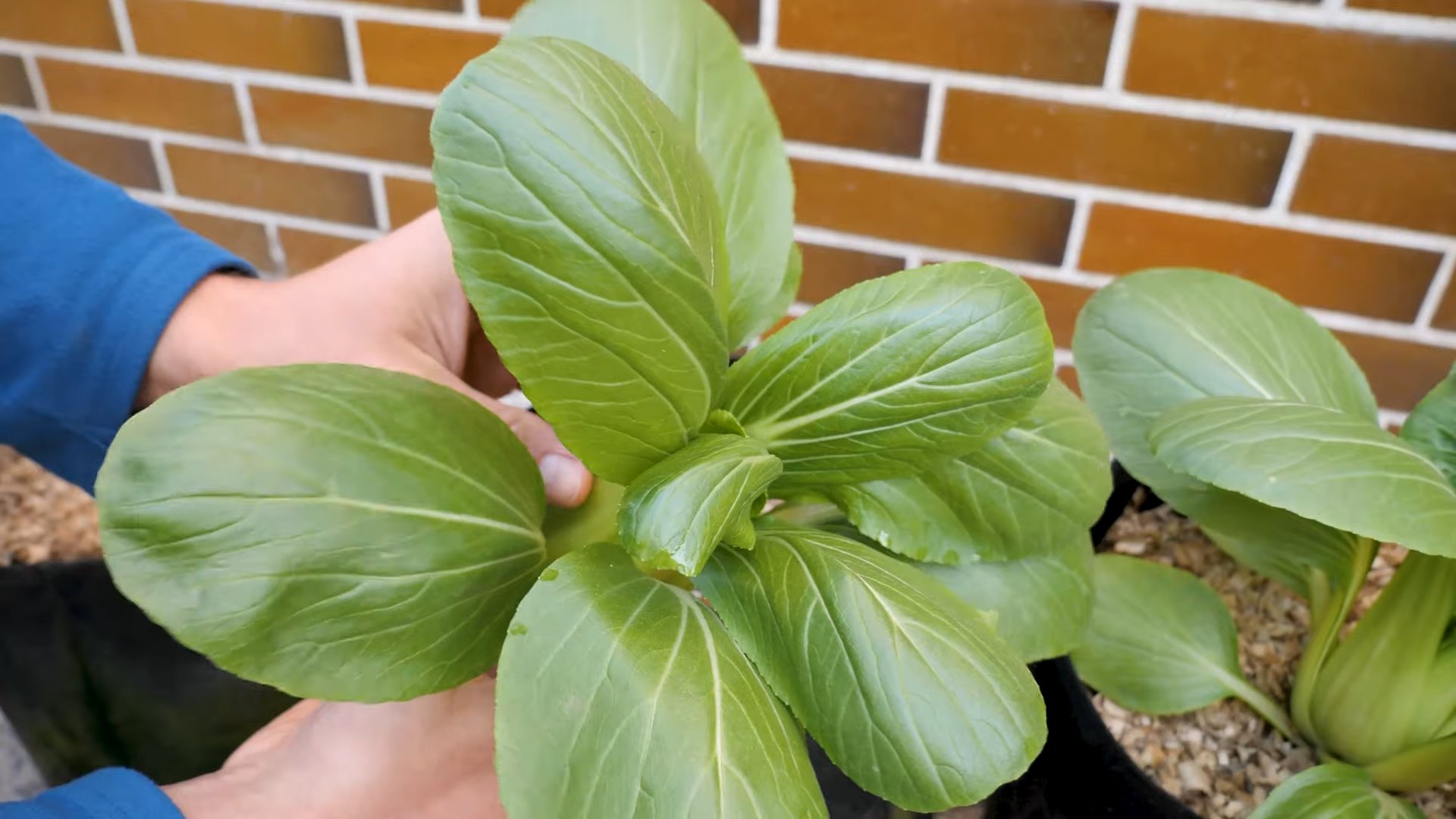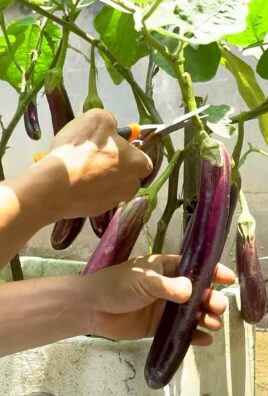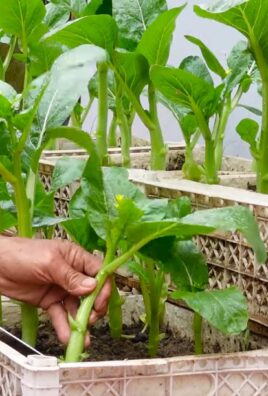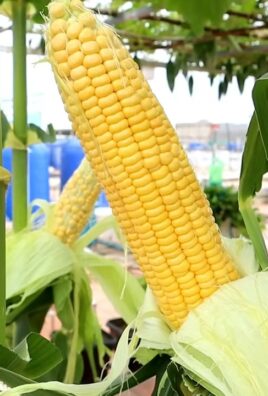Grow Bok Choy in Grow Bags: A Gardener’s Delight
I’ve always loved the satisfying crunch of fresh bok choy, but finding consistently good quality at the supermarket can be a challenge. That’s why I started growing my own, and I discovered that grow bok choy in grow bags is the easiest and most rewarding method! This article is packed with simple DIY tricks and hacks to help you achieve a bountiful harvest, even if you have limited space or gardening experience.
Historically, bok choy, a member of the brassica family, has been a staple in East Asian cuisine for centuries, prized for its nutritional value and versatility. From simple stir-fries to elegant dumplings, its delicate flavor and crisp texture make it a culinary favorite. But you don’t need a vast vegetable patch to enjoy this delicious green. The beauty of using grow bags for your bok choy is that it allows you to cultivate this nutritious vegetable practically anywhere – on a balcony, patio, or even a sunny windowsill.
Why bother with grow bok choy in grow bags? Because it offers unparalleled convenience and control. Grow bags provide excellent drainage, preventing root rot – a common problem with bok choy. They’re also lightweight and portable, making them perfect for those with limited space or mobility. Plus, you’ll know exactly what’s gone into your bok choy, ensuring it’s free from pesticides and other harmful chemicals. You’ll be amazed at how easy it is to grow your own delicious, healthy bok choy using this simple method. Let’s get started!

Growing Bok Choy in Grow Bags: A Step-by-Step Guide
I love bok choy! It’s so versatile and easy to grow, even for a beginner like me. And using grow bags makes it even simpler. No need for a big garden – you can do this on a balcony or patio!
Choosing Your Grow Bags and Location
- Select the right size: I recommend grow bags that are at least 12 inches wide and 12 inches deep. This gives your bok choy plenty of room to develop its root system. Larger bags are even better!
- Material matters: Look for grow bags made from durable, breathable material. Non-woven polypropylene is a great choice. Avoid plastic bags that don’t allow for proper drainage and aeration.
- Sunlight is key: Bok choy needs at least six hours of sunlight per day. Choose a sunny spot on your patio, balcony, or even a sunny windowsill (for smaller bags). If you don’t have direct sunlight, consider a grow light.
- Drainage is crucial: Make sure your chosen location has good drainage to prevent waterlogging, which can rot your bok choy.
Preparing the Grow Bags and Soil
- Gather your supplies: You’ll need your grow bags, potting mix (a good quality seed-starting mix is ideal), a small trowel or hand cultivator, and water.
- Fill the bags: Fill each grow bag about ¾ full with the potting mix. Don’t pack it down too tightly; leave it loose and airy. This allows for better root penetration and drainage.
- Water thoroughly: Once the bags are filled, water them generously. The soil should be evenly moist but not soggy. Let the excess water drain completely before proceeding.
- Consider adding compost: Adding a small amount of compost to the potting mix will enrich the soil and provide essential nutrients for your bok choy. Mix it in gently.
Planting Your Bok Choy Seeds
- Sow the seeds: Plant your bok choy seeds about ½ inch deep and 2-3 inches apart. If you’re using larger bags, you can plant more seeds. Remember, you can always thin them out later.
- Gently cover the seeds: After planting, lightly cover the seeds with the potting mix. Don’t press down too hard.
- Water gently: Use a gentle spray or watering can to water the seeds. Avoid disturbing the soil.
- Label your bags: It’s a good idea to label your grow bags with the planting date and type of bok choy you’ve planted. This will help you track their progress.
Caring for Your Bok Choy
- Consistent watering: Keep the soil consistently moist but not waterlogged. Water regularly, especially during hot and dry weather. Check the soil moisture by sticking your finger a couple of inches into the soil. If it feels dry, it’s time to water.
- Sunlight monitoring: Ensure your bok choy receives at least six hours of sunlight daily. Adjust the position of your grow bags if necessary to maximize sun exposure.
- Thinning: Once your bok choy seedlings have a few true leaves (the leaves that appear after the initial cotyledons), thin them out to give each plant enough space to grow. Leave about 6-8 inches between plants.
- Fertilizing: You can fertilize your bok choy every 2-3 weeks with a balanced liquid fertilizer diluted to half strength. Follow the instructions on the fertilizer packaging.
- Pest and disease control: Regularly inspect your bok choy for pests or diseases. If you notice any problems, address them promptly. Organic pest control methods are often effective.
- Weed control: Remove any weeds that may compete with your bok choy for nutrients and water. This is easier in grow bags than in the ground.
Harvesting Your Bok Choy
- Harvest time: Bok choy is typically ready for harvest 4-6 weeks after planting, depending on the variety. The leaves should be firm and dark green.
- Harvesting method: To harvest, simply cut the bok choy at the base of the stem, leaving a small portion of the stem in the ground. This can encourage further growth from the base.
- Enjoy your harvest: Wash your freshly harvested bok choy and enjoy it in your favorite recipes!
Troubleshooting Common Problems
Yellowing Leaves
Yellowing leaves can indicate several issues, including overwatering, underwatering, nutrient deficiencies, or pest infestations. Check your watering schedule, soil moisture, and inspect the plants for pests. Consider adding fertilizer if needed.
Slow Growth
Slow growth can be caused by insufficient sunlight, poor soil quality, or lack of nutrients. Ensure your bok choy receives enough sunlight and consider amending the soil with compost or fertilizer.
Pest Infestations
Common pests include aphids, slugs, and caterpillars. Inspect your plants regularly and take action if you notice any pests. Organic pest control methods, such as insecticidal soap or neem oil, are often effective.
Remember to always research specific pest control methods before applying them to your plants.

Conclusion
So there you have it – a foolproof method for growing luscious, vibrant bok choy, all from the convenience of your own grow bags! This DIY approach offers a wealth of benefits, surpassing the limitations of traditional gardening. The ease of setup and maintenance makes it perfect for beginners and seasoned gardeners alike, while the controlled environment ensures optimal growth, resulting in a bountiful harvest of delicious bok choy. Forget battling unpredictable weather conditions or struggling with soil-borne diseases; this grow bag method offers a clean, efficient, and rewarding gardening experience. You’ll be amazed at the speed and ease with which your bok choy thrives, providing you with fresh, homegrown vegetables in a fraction of the time it would take in a traditional garden. This simple yet effective grow bok choy grow bags technique truly unlocks the potential for anyone to enjoy the pleasures of homegrown produce, regardless of space constraints or gardening expertise.
Beyond the basic method outlined, the possibilities for customization are endless. Experiment with different varieties of bok choy – from the classic baby bok choy to the more robust, larger varieties. Consider adding a slow-release fertilizer to your potting mix for even more robust growth. For those with limited sunlight, explore the use of grow lights to supplement natural light, especially during the shorter days of autumn and winter. You can even try incorporating companion planting techniques, such as planting herbs like basil or dill nearby to deter pests and enhance the overall flavor profile of your bok choy. The beauty of this method lies in its adaptability; feel free to tailor it to your specific needs and preferences.
We strongly encourage you to try this grow bok choy grow bags method yourself. The satisfaction of harvesting your own homegrown bok choy is unparalleled. It’s a rewarding experience that connects you to the source of your food and allows you to enjoy the freshest, most flavorful bok choy imaginable. Share your experience with us! Post pictures of your thriving bok choy plants on social media using #GrowBokChoyGrowBags and tag us – we’d love to see your success stories and learn from your experiences. Let’s build a community of home gardeners, sharing tips, tricks, and the joy of growing our own food.
Don’t delay – embark on this rewarding gardening adventure today! The journey from seed to plate is surprisingly short and incredibly satisfying. You’ll be amazed at how easy it is to cultivate your own delicious, healthy bok choy using this simple and effective grow bag technique. Get started now and experience the joy of homegrown goodness!
Frequently Asked Questions
What type of grow bags are best for growing bok choy?
While any grow bag will work, we recommend using non-woven polypropylene grow bags. These are durable, breathable, and allow for proper drainage, preventing root rot. Look for bags that are at least 5 gallons in size to give your bok choy ample room to grow. Avoid using plastic bags that don’t allow for adequate air circulation.
What kind of soil mix should I use?
A well-draining potting mix is crucial for successful bok choy cultivation. A commercial potting mix designed for vegetables is ideal. You can also create your own blend by combining peat moss, perlite, and compost. Ensure the mix is rich in organic matter to provide essential nutrients for healthy growth. Avoid using garden soil directly, as it may contain diseases or pests.
How much sunlight does bok choy need?
Bok choy thrives in full sun to partial shade. Aim for at least 6 hours of sunlight per day. If you’re growing bok choy indoors, supplement natural light with grow lights to ensure adequate illumination. Too little light can lead to leggy growth, while too much direct sunlight can scorch the leaves.
How often should I water my bok choy?
Keep the soil consistently moist but not waterlogged. Water thoroughly when the top inch of soil feels dry to the touch. The frequency of watering will depend on factors such as temperature, humidity, and the size of your grow bag. During hot weather, you may need to water more frequently. Always check the moisture level before watering to avoid overwatering.
How long does it take for bok choy to mature?
The time it takes for bok choy to mature depends on the variety and growing conditions. Generally, most varieties are ready for harvest in 45-60 days from sowing. You can start harvesting baby bok choy leaves earlier, even as early as 30 days, for a continuous harvest.
What are some common problems when growing bok choy in grow bags?
Overwatering is a common issue that can lead to root rot. Ensure your grow bags have adequate drainage holes and avoid overwatering. Pest infestations are less common in grow bags but can still occur. Regularly inspect your plants for any signs of pests and take appropriate action if necessary. Nutrient deficiencies can also occur, so using a balanced fertilizer can help prevent this.
Can I reuse the grow bags for another planting?
Yes, you can reuse the grow bags after thoroughly cleaning and disinfecting them. Remove any remaining soil and debris. Wash the bags with soapy water and rinse thoroughly. Then, disinfect the bags using a solution of bleach and water (1 part bleach to 9 parts water). Allow the bags to dry completely before using them again for a new planting.
What should I do if my bok choy is bolting?
Bolting, where the plant sends up a flower stalk, is often caused by stress, such as high temperatures or long days. While bolting doesn’t necessarily ruin the plant, it can make the leaves bitter. To prevent bolting, ensure your bok choy receives adequate water and avoid planting during excessively hot periods. Harvest the leaves as soon as possible if bolting occurs.





Leave a Comment